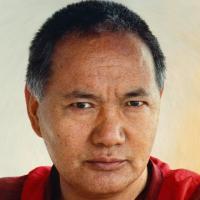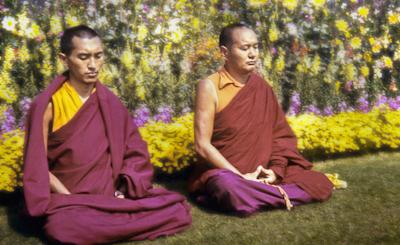Emptiness: Causative phenomena are in the nature of subtle impermanence
The last prayer, the first stanza I mentioned yesterday, the next stanza, the very last one, “Look at causative phenomena, like stars”, this expresses how they are in the nature of impermanence. A shooting star appears then disappears, like at dusk, when it is not completely dark, after sunset but not completely dark, when there is shimmering. As it appears it doesn’t exist. So here, it shows that.
That example shows that we have some appearance but in reality there is no such thing there. There is a bush but at dusk we see a tiger or an animal or a person, something like that. It appears but it’s not true. In reality if there is a piece of rope that is coiled like a snake, it appears to us as if there really is a snake there on the road. As it appears, but it’s not there. Like that, causative phenomena, including our own I, our own life, the sense objects, our family, enemies, strangers, possessions, surrounding people, the five sense objects, all these causative phenomena don’t exist as they appear.
Except it doesn’t stop there; it doesn’t finish there. Causative phenomena are in the nature of impermanence; they don’t last, they are indefinite, uncertain. Causative phenomena are in the nature of impermanence, therefore there is nothing to cling to. That becomes the reason—there is nothing to cling to or nothing to get angry about. The reason is this, that these phenomena in our life are in the nature of impermanence. Not only that they get older and perish but they don’t last, even from hour to hour, minute to minute, second to second, they don’t last. They perish, they decay, even from second to second, minute to minute. Year by year, month by month, week by week, day by day, hour by hour, they also decay. That means they don’t last. And why, because they change, they decay, they don’t last even minute by minute. They do not last even minute by minute and that is because they don’t last second by second. They don’t last and they decay even second by second. And not only that, even within a second. Not only second to second but even within a second, like the duration of this, [finger snap] like a finger snap. It’s called one second of completing the action. So this [finger snap] this second is called the duration of this, the second of completing the action.
[Conversation in Tibetan]
This duration [finger snap] in Tibetan is called [Rinpoche gives the Tibetan], this second of completing the action, this one second of completing the action. So even within that second, these causative phenomena do not last, including our own life, our own body, all these sense objects; they do not last. They change even within a second, they decay even within a second.
What exists in the first second is gone by the next second. It’s not there, it’s gone. Today’s you will not exist tomorrow. So what exists in the first second, during the first second, is gone by the next second.
By reflecting, meditating and analyzing on the nature of impermanence, it is helpful, it is helpful. That’s the reality of what’s happening. That does affect attachment, you know. This is the nature of phenomena, so to discover this is the nature, that it doesn’t last, this is the reality of causative phenomena, it affects the delusion, attachment, seeing that it does not exist, that after the first second it has gone in the next second. It is surprising, there is no interest in being attached to this thing, by thinking this way. This is not thinking about emptiness; this is analysis of the conventional nature of how things perish and decay, how they change continuously. When we don’t meditate and analyze how things are in the nature of impermanence, which is the reality, we have this hallucination and they appear as permanent and we believe them to be permanent. That is not what is happening. This is the view that we have, the hallucinated view, the view of permanence.
We have this hallucinatory view, this view of permanence, and we believe in that. We follow the hallucinated mind, this concept of permanence, this delusion and believe in that. But in the view of wisdom, discovering the nature of impermanence, it is totally something else. Even without the ultimate nature, emptiness, just seeing impermanence, just the nature of impermanence, that is our nature, that is something else.
This is how things are in the nature of suffering. It doesn’t mean we don’t feel any suffering. It doesn’t mean that, but the nature of impermanence is that nothing lasts. That includes our own body, our own life, other people’s bodies, this beautiful flower—they are all the same. The way we look at it, it looks like permanent; it doesn’t appear impermanent. Maybe in the morning and afternoon, or day after day, maybe we see some difference, when there is some color change, when it’s a very gross change like that. With the gross nature of the phenomenon, the very gross change, then we can see there is some change but while we are looking at it, in reality it’s changing, decaying continuously. The first-second’s flower is gone by the next second. Then, the next-second’s flower is gone by the third second. So like that. When we hear or see it’s gone, it’s something kind of sad. It’s something kind of sad, the nature. It doesn’t last. It doesn’t exist after the first second; it’s gone by the next second. It’s sad.
Even from this analysis, this meditation, even from this analysis, this discovery of the conventional nature, impermanence, you see there is nothing to cling on to. Within a minute, how many seconds in one minute? [Student replies] Sixty-four? Sixty-six? One way of looking at it, the flower. So, there are sixty-six, sixty-four—sorry? Huh? [Student explains] How many seconds? There are not sixty-four seconds? So how many seconds in a minute? [Student explains] How many seconds within one minute? Sixty! So, it became less! [Laughter] Anyway, decaying second by second, changing, decaying—that is subtle impermanence. It’s changing, decaying even in this second. That is the third type of impermanence, the very subtle nature of impermanence. There is gross, subtle and very subtle. So including the changing, decaying within each second.
With this awareness of the reality of phenomena, with this discovery, there is nothing to be attached to. Even in that sense, there is no such concrete thing there—here, concrete in the sense of permanence. Anything that appears permanent and not changing, is decaying continuously, but when we don’t see that then it looks like it’s worth being attached to.
All phenomena are like this, whatever we see, whatever we hear. Whatever beautiful object, what we believe as beautiful—a beautiful body or beautiful car and so forth, any beautiful object—even though it appears permanent and we believe that it is going to be always like this. When we look at the flower, we believe it’s always going to be like that. It appears as permanent, then we think it’s always going to be like that. When we don’t use reasoning, analysis, it seems like it’s always going to be like that. The car is always going to be like that or the person’s body is always going to be beautiful like this. There is something concrete or something permanent in the appearance, in the situation. But in reality it’s all changing, decaying, getting older, day by day, hour by hour, minute by minute, second by second, within one second. It does not last, it does not exist by the next second.
What exists during the first minute doesn’t exist during the next minute; it’s gone. In the same way, what exists during the first hour is gone by the second hour. So, it’s always changing, decaying.
This is the nature of suffering, that these phenomena, which are caused by karma and delusion, by depending on these objects then also delusion rises. That is the nature of suffering.
Like a Candle Flame
The Tibetan rab rib means having a vision, a person having a hallucination, like a hair falling down on the food. What it is saying is that these causative phenomena don’t exist as they appear to us. That’s all. Usually they use this as an example. Rab rib.
One time, in Milan, Italy, while I was at the airport, I was standing there and I saw a person standing so still I thought it was a shop mannequin. Because there were so many mannequins around, all dressed so well, I thought it was a mannequin but it was a real person. On another occasion exactly the opposite happened. I saw what I thought was a real person, but when I went closer I saw it was a mannequin. [Laughter] Anyway, that’s an example of rab rib, how causative phenomena don’t exist as they appear to us.
Then, the next one shows how they are in nature of impermanence, like a candle flame flickering in the wind. Before it ends, a candle flickers, so it can be stopped any time, like flickering light, like a candle standing in the midst of the wind, that can stop any time. That is an example of how causative phenomena can perish or they can be ceased at any time.
Even very huge concrete buildings that we think are always going to be like this, completely permanent, suddenly collapse when an earthquake happens. Suddenly an earthquake happens, and it totally changes; the building collapses. Or a bomb, or a tornado—not tomato, tornado, not tomato, especially not an Italian tomato. [Laughter] Anyway, it’s completely destroyed. It looked really permanent, like it was always going to be like this, but then suddenly it’s gone. Even this earth, one day it’s gone, this whole entire earth will be gone. Where there was this earth, there will be nothing there, just space. That is the nature of impermanence.
Like an illusion
Then, like an illusion, again that’s another example of how causative phenomena don’t exist as they appear to us. They are like an illusion. A magician person illusions us a beautiful house or beautiful man or woman or car or a billion dollars, beautiful parks. He illusions a beautiful park; he illusions a whole city. We have the appearance of all these things but they are not real; they don’t exist. As they appear to us, they don’t exist at all like that. All causative phenomena don’t exist as they appear to us. I already mentioned that yesterday, so that should give you some idea.
Today, I wanted to go through this teaching of the Buddha and this verse that comes before the teachings all the time, to bring our mind, which is distracted by outside sense objects and pleasures, to bring it back, to look at the very nature of the phenomena, to look at the very nature of life. Our mind is always distracted, hallucinating, believing that it is real, permanent, appearing inherently existent, true. Now here, you see, we are looking at the very nature of the life.
The nature of causative phenomena is that it’s impermanent and empty of existing from its own side, which we call real. Our definition of “real” is what appears and what we believe is real, the definition of that is “existing from its own side.” If we put it into words, that describes what “real” means to us. Things appear not merely labeled by mind and we believe this is true. Whether we are able to express this in words or not, this is what is in our heart. If somebody tells us this isn’t like that, it really upsets us. How dare you tell me this doesn’t exist! I can see it exists!
When common people talk in daily life, when they use the expression “real,” that is actually expressing the object to be refuted. They don’t know they are saying this, that what the word “real” or some similar word contains is the object to be refuted, the hallucination, that which is believed, that thing that appears as not merely labeled by mind and that is true. That concept becomes the basis for the delusions. And the view of that ignorance, the hallucination which is the view of that ignorance—of a truly existent phenomenon—becomes the basis to be attached to, to be angry about, to be jealous of. That becomes the object of attachment; that becomes the object to be angry about, to be jealous of—but in reality there is no such thing.
First of all there is the view of ignorance and from that all the rest of the delusions build up. All the emotional thoughts build up on the basis of the view of the ignorance, which is only a hallucination. Whatever appears is believed, but it does not exist. It is believed by the ignorance, but it does not exist at all, not even one atom. Therefore, how can the object of attachment exist? How can the object of anger exist? That is a hallucination; the view of attachment is a double attachment, the view of anger is a double hallucination, the view of jealousy is a double hallucination—all built up on the basis of the view of the ignorance, which is a hallucination. That’s how we are living our life. That’s how we are living our life—on top of one hallucination, there is another hallucination built up.
So this way, this is how sentient beings suffer. This is the way sentient beings circle in samsara continuously, including us, continuously circling in samsara. This is not the first time, our circling in samsara, experiencing all the sufferings; this continuation has no beginning. Our continual circling in samsara, experiencing all these sufferings, does not have a beginning; it’s beginningless.
So that means, when we think of that, this is not the first time in this life and this is not the first life where we have experienced these hallucinatory sufferings, all these wrong beliefs, these wrong conceptions, these piled up hallucinations, like building a stupa or a wall, putting one brick on top of another. Our hallucinations pile up and we believe they are real. By the wrong concepts, the delusions, this is not the first time we have suffering like this. We are totally trapped in all these hallucinations, which are wrong concepts, delusions, totally consumed by all these piles of hallucinations, overwhelmed or possessed, under all these wrong concepts. And this is not the first time; this is not the beginning The continuity of this suffering has no beginning; it is beginningless. When we think that this experience is beginningless, all these sufferings, all this hallucination is beginningless, all these delusion are beginningless, that really makes us to think that we must do something, we must do something right away. We can’t wait; we can’t bear it any longer. We must do something to be free from this prison. We’re enveloped by all these wrong conceptions, all these hallucinations; we’re gloomed by them.
When we think of beginningless time, that really makes us think we must do something—there is no choice, we must do something, whatever we can do in this life, we must do it right away, because we can lose this opportunity at any time. We can lose this opportunity to practice, this opportunity to realize the nature of phenomena, impermanence and death, and to realize emptiness. We must actualize the path that removes the gross and subtle defilements; we must actualize the path in this life. Even more, we must do it right away, right away; we can’t wait, we cannot wait. We can’t stand the suffering, which has been controlled by delusion from time without beginning—that one has been controlled.
Usually people make a big noise about not being controlled by somebody else, not being dictated to by somebody, but actually we have been controlled by delusion from time without beginning. From time without beginning, from beginningless rebirth, we have never had freedom. We have never had freedom from all these delusions and karma. We have never had freedom for even one second, freedom from delusions, freedom from this ignorance. We have never had one second’s freedom, not possessed, not contaminated, not overwhelmed, controlled by delusion, by this ignorance.
So, actualizing this path, practicing this Dharma becomes the most important thing in our life to do, more important than anything else. This becomes a more important thing than anything else in our life.
If we don’t do something now in this life, in this present life while we have the opportunity, we will have to suffer again, we will have to circle in this samsara and continuously suffer from this hallucination, trapped in the net of all these hallucinations, contaminated or possessed, controlled by delusions and wrong concepts and suffer continuously. That’s why Buddha gave this essential advice to meditate, to realize how phenomena are in the nature of impermanence and how they don’t exist as they appear to us, giving these examples.
More analogies of how things appear
Then, like dew. Causative phenomena are like dew that is on a plant but can drop at any moment. Like that, causative phenomena can cease at any time, can be stopped at any time. They are like water dew—including our own life; they can be stopped at any time. This precious human life can be stopped at any time, just as dew can drop from a flower at any time. At any moment it can drop.
Next is like a dream. Here, what it is saying is that things appear like in the dream. Things, phenomena, people and the other phenomena appear to us in a certain way and we believe they exist in that way, but they do not exist in that way at all. We dream something and in the dream we have attachment, we get angry and have all these emotional thoughts, like in the daytime, believing that they are real. Even things that we see in a dream appear to us, we are unable to recognize or realize as a hallucination, that they are not true, besides being unable to recognize the truly existent appearance as a hallucination, as false. Phenomena do not exist as they appear to us, which means truly existent, just as things in a dream appear to us and while we are dreaming we believe they exist.
Then next one, like lightning. This one shows the nature of impermanence, that causative phenomena do not last, that they are in the nature of change. In that, they are like lightning—it happens and it’s gone. During the flash of lightning itself, we see phenomena—we see trees, houses and those things—and there is such a vivid appearance. There is vivid appearance, it happens and it’s gone. It happens, it’s gone. So like this, this life’s friend, enemy, our entire possessions, property, buildings, houses, however much we have, our wealth, including friends, enemies, all the family members, including our own human body—all these sense objects appear and then stop. They appear, then they stop, they’re gone. When we die, it’s like this. It happens, it’s gone. When death comes to us, this is what we get.
The concept of permanence makes us think we are going to live for a long time, but when death comes we see that this whole appearance of life is as brief as a flash of lightning. It’s exactly like lightning—it appears, it’s gone. It happens, it’s gone. Our own life is like a dream. This shows the nature of impermanence.
Then, like clouds. That shows how causative phenomena are in the nature of impermanence, like clouds. While we are looking at clouds in the sky, they are always changing. They change; they do not last. We see a cloud there, and the next minute it’s not there; it’s disappeared. While we are looking at it, it’s changing. Causative phenomena, like clouds, do not last; they are forever changing, decaying. This shows how causative phenomena are in the nature of impermanence.
The conclusion is this. Our hallucinated appearance is that they are permanent while they are impermanent, and while they are empty of existing from their own side, they have the appearance of existing from their own side and we believe in that. We believe the common appearance, believing the permanent appearance as permanent. Causative phenomena appear to be permanent and we believe that is true. Causative phenomena appear to be truly existent and we believe that is true. Our ignorance believing that these causative phenomena are permanent and truly existent becomes the cause of samsara. It becomes the cause of samsara, the cause of the oceans of each realm’s suffering—the oceans of hell realm’s suffering, the oceans of the hungry ghost realm’s suffering, the oceans of suffering of the realms of the animal, the human being, the sura, the asura. It becomes the cause of the oceans of each of those realm’s suffering, as well as the bases for all other delusions, all the rest of the delusions and then karma.
If we live our life with these wrong concepts, this ignorance—while things are empty of existing from their own side, we believe that they exist from their own side, and while they are impermanent in nature, we believe that they are permanent—what does this wrong concept do to us? The harm it does us is like the limitless sky. It does inconceivable harm, incredible suffering.
Therefore, what we need to do is practice the opposite. We need to see that it is a wrong concept to believe that what is impermanent is permanent, that what is empty of true existence is truly existent. We need the opposite of wrong view, of ignorance; we need right view, the wisdom realizing emptiness. We need correct thought, the awareness that life and the causative phenomena are in the nature of impermanence. These right thoughts, the thought of impermanence and the wisdom realizing emptiness, free us from attachment, anger, ignorance and all those other delusions, and stop us creating negative karma. They protect us from all the oceans of samsaric sufferings. They help us to not create, to not experience the oceans of samsaric suffering again and again, again and again, without end.
By meditating, practicing mindfulness, realizing how the nature of phenomena is impermanence, and practicing mindfulness that causative phenomena’s nature is empty, thus what appears as existing from its own side, we recognize that is a hallucination as it is a hallucination. We need to practice mindfulness of that—that causative phenomena exist being merely labeled by mind. We need to practice mindfulness of subtle dependent arising. It’s the realization of this that especially cuts ignorance, the root of samsara. And not only that, it ceases all the delusions, including the seed of delusion, and then we are able to achieve the nature of the mind which is free from all disturbing thoughts, from all obscurations. That is nirvana, the sorrowless state, the ultimate happiness.
With the support of bodhicitta, great compassion toward sentient beings, bodhicitta, we enter the Mahayana path. Wisdom is supported by method—we develop method, we practice method supported by wisdom—then we are able to cease even the subtle defilements and achieve the two kayas, rupakaya and dharmakaya, a buddha’s holy body and mind.
So, I’ll stop there.






























